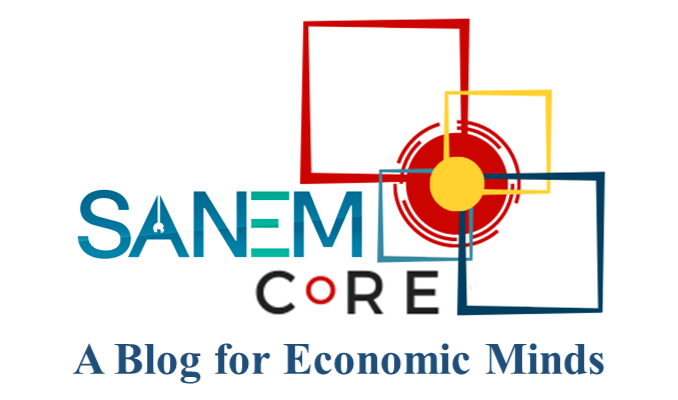In the literature of export-growth linkages, the issue of export diversification draws a considerable interest in reducing risks associated with adverse and volatile terms of trade, slow productivity growth or relatively low-value addition in the global value chain. Diversification of exports can lead to reducing the dependence on fluctuating commodity prices as well as can encourage other technology-intensive sectors through triggering the knowledge spillovers, which could be attained from the exposure to international markets, business practices, and production processes. A number of empirical studies have shown strong relationships between economic growth and export diversification. While previous studies tried to correlate export diversification with investment, economic structure, and development, the objective of our current article is to find out major factors that influence differences in export diversification across countries and time.
For constructing the model, index of export diversification is considered as the dependant variable while the explanatory variables of the model are log of per capita GDP, gross fixed capital formation (as % of GDP), domestic credit to the private sector (as % of GDP), tariff rates (both average MFN and weighted mean applied for all products in %), doing business indicators and institutional variables. Taking into consideration of the individualistic effect, a fixed effect panel regression is used over the period of 1962 to 2010 for 182 countries. In another set of regressions, LDC, Land Locked and Island dummies are used for desegregating the impacts of these variables over the export diversification. In this respect, an LSDV model is applied.
The export diversification index is taken from the Export Diversification and Quality Databases (an IMF-DFID collaboration). From the database, data of 182 countries are considered for the period of 1962-2010. The higher value of the index indicates lower diversification; and therefore, for a better understating, we term this index as export concentration index. The data of per capita GDP, investment, tariff rates, and credit to the private sector are taken from the World Bank World Development Indicator database. The doing business indicators are taken from the Doing Business database. Institutional variables are adopted from the International Country Risk Guide (ICRG) database. The LDC country dummy variable is created using the UNCTAD’s list of LDC countries while the dummy variables for landlocked countries and island countries are created using Wikipedia.
In the first set of regressions, we have used log of per capita GDP, domestic credit to the private sector and investment. The regression result shows a strong negative association between economic development and export concentration index which means that with economic development a country’s export basket tends to be more diversified. With the rise of per capita GDP by 10%, the export concentration index will decline by 0.01 points. Analogously, investment and domestic credit to the private sector (as % of GDP) are negatively associated with export concentration. Although the associated coefficients of these explanatory variables are small in magnitude, the strong significance resembles two facts: (i) a strong backbone of financial institutions which promotes smooth flows of credit to the private sector can lead a country towards greater diversification of exports; and (ii) a higher level of investment leads towards a greater level of diversifications. On the contrary, despite the existence of a common belief that tariff liberalization leads to greater export diversification, the current study found no significant association between these two variables. Both MFN tariff and weighted applied tariff rates are found to be insignificant. Moreover, the time-invariant dummies, namely, LDC, landlock and island dummies are found strongly significant and associated positively to the export concentration index. On average, for a country of LDC the export concentration index is higher than that of a non-LDC by 1.48 points, which shows that LDCs’ export baskets are more concentrated than those of non-LDCs. The result also shows that export baskets of land-locked economies are more concentrated than those of non-landlocked economies. A reason behind this could be the high cost of exports and dependence on other countries by the landlocked countries for shipment procedures. Analogous to the previous dummies, export baskets of Island economies are appeared to be more concentrated than those of non-island economies.
A similar picture is also depicted in the Table, which shows the list of the top 10 most diversified economies. All of the countries in the top 10 list are developed countries. Not only that, but all of the top 40 most diversified countries are also non-LDC developing/developed countries. We also see from the list of 10 least diversified countries that among them 4 are LDCs. The dominant presence of countries from Sub-Saharan Africa in the list is also noticeable. In 2010, among the South Asian countries, India tops the list being the most diversified economy in the region with a global position of 23rd while Bangladesh ranks the bottom with a global position of 155th among the 182 countries.

It is important to explore the effects of the different business environments and institutional variables on the cross-country and over time differences in export concentration index. In this regard, we have used doing business indicators from the World Bank’s Doing Business Survey, with a time period of 2004 to 2010 for 166 countries. For convenience, distance to frontier (DTF) of different indicators is considered as the representative variable. The DTF score benchmarks economies with respect to regulatory best practice, which shows the absolute distance to the best performance on each Doing Business indicator. An economy’s DTF is scored on a scale of 0 to 100, where zero represents the worst performance and 100 the frontier. Among the indicators, four indicators appear to have statistically significant negative effect on the export concentration index. For example, an increase in the DTF of starting a business by 1 unit would lead to a fall in the export concentration index by 0.005 units. If the DTF of getting credit increases by 1 unit the index of export concentration decreases by 0.002 units. Analogously, a rise in the DTF of enforcing contracts by 1 unit can reduce the export concentration index by 0.02 units. All of these results suggest a positive correlation between the ease of doing business and export diversification.
In the case of institutional variables, we have considered 6 political risk variables from the ICRG database (for details see: http://www.prsgroup.com) for 126 countries over a time period of 1984 to 2010. These are bureaucracy quality, government stability, democratic accountability, investment profile, corruption, and law and order. The regression results show that all these institutional variables, except investment profile, have a negative and statistically significant effect on the export concentration index. It follows that improvement in all these parameters would promote further export diversification. A point rise in bureaucratic quality (on a scale of 0-4) would reduce the index of export concentration by 0.03 points. A point rise in government stability (on a scale of 0-12) would lead to a decline in the export concentration index by 0.02 points. A point rise in democratic accountability (on a scale of 0-6) would lead to a fall in the export concentration index by 0.02 points. A point improvement in the control of corruption (on a scale of 0-6) would reduce the export concentration index by 0.03 points. A point improvement in law and order (on a scale of 0-6) would result in a 0.05 points decline in the export concentration index. Results found in this model suffice the reality: for promoting export diversification – improvement in institutional variables is very critical.
The analysis thus points out the necessity of addressing the supply side issues with economic and policy reforms. For promoting diversified and technology-driven exports – greater access to credit along with the increment of productive investment is a pre-condition. Institutional reforms should be undertaken with a view to reducing the cost of doing business.
This article is written by Dr. Selim Raihan and Mahtab Uddin.




RECENT COMMENTS